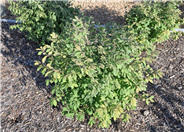
Common name:Compact Burning Bush
Botanical name:Euonymus alatus 'Compacta'
"Compacta" is a dwarf form of burning bush, growing 6 to 8 feet tall and wide. Like the speices, leaves emerge in the spring a bright, luminous green, mature to a dullish medium to dark green, and turn a brilliant scarlet to burgundy in the fall. After the leaves drop, the interesting wood is exposed, with corky "wings" along the length of the stems. New wood displays green and brown wood, older wood is a warm grey brown. Little yellow flowers appear May and June, and though not showy, they are charming.
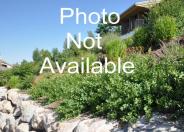
Common name:Serbian Bellflower
Botanical name:Campanula poscharskyana
Serbian bellflower has star-shaped, pale blue, violet, or white flowers that are borne in loose panicles from late spring to early summer. The foliage is rounded, with a pointed leaf tip, and is finely toothed. It has a creeping, trailing habit, and grows about 8 to 12" tall and 12" wide. It is well suited to the front of a border, at the top of a low wall, or around rocks where its trailing habit is at advantage. A number of cultivars are available, differing in flower color and bloom time-range.
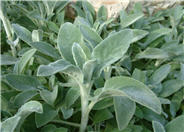
Common name:Lambs' Ear
Botanical name:Stachys byzantina
Lambs' ear is a most fabulous perennial and groundcover, grown primarily for its soft, velvety leaves. It grows about a foot or so tall and spreads 2 to 3 feet. Leaves are grey-green and hairy, with the hairs giving the leaves a silvery cast. Though not really evergreen, the leaves turn a lovely buff come fall and persist well into the winter months, until buried under snow. Erect flowering stems arise May and June, with pink to lavender flowers at the terminal end. Some remove the flower stems before they bloom, but they are simple and charming. Use as a edging plant for a perennial, shrub, or foundation border, or as a ground cover. There are some named cultivars; 'Helene Von Stein' and 'Big Wave' claim to be flowerless, though in my experience they all eventually come to flower. Leaves are wonderful on wreaths (but you'll need a glue gun). There are lambs ear planted at the Washington Square Demonstration Garden.
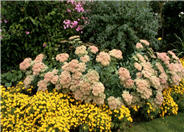
Common name:Autumn Joy Sedum
Botanical name:Sedum 'Autumn Joy'
Autumn Joy sedum is a garden staple, and for good reason. Emerging in early spring, fleshy, green to grey-green leaves form a rosette of foliage, and soon expands on sturdy stems, growing about 18 to 24 inches tall and wide. Flower heads begin to form in early to mid summer, looking something like little cauliflower, but soon the buds open to pale pink stars that progressively deepen in color, until they become a russet red in the fall. Use in perennial, shrub, or foundation borders, in parkstrips, with ornamental grasses. Attracts butterflies and bees. Flower heads persist well into winter.
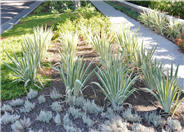
Common name:Variegated Iris
Botanical name:Iris pallida 'Variegata'
If I had to pick my top five must-have perennials, this would be on the list. A species of bearded iris, yellow variegated iris has long, sword like foliage that emerges in early spring and is colored pale, grey-green and lemony yellow. Flowers bloom late spring to early summer, are a pale blue to violet-blue, and are very fragrant (like a cross between grape and apple juice). Absolutely fills the yard. And after flowering, the foliage holds out all summer, unlike other bearded iris; the variegated leaves a striking presence, even without the flowers. The foliage is about 18 to 24 inches tall, and the flowers rise to about 30 to 40 inches. I have never had a garden that didn't include this iris. There is also a variety with white variegation, usually listed as Iris p. 'Argenta.' Fabulous anywhere, and plant enough so you can cut them and bring them indoors.
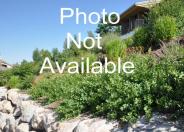
Common name:Peking Cotoneaster
Botanical name:Cotoneaster acutifolius
A deciduous cotoneaster with dull green leaves, small white flowers in mid to late May, and black berries in late summer persisting into autumn. The tiny leaves turn varying shades of red and orange in autumn. It grows 6 to 10 feet tall and nearly as wide.
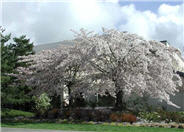
Common name:Akebono Yoshino Cherry
Botanical name:Prunus x yedoensis 'Akebono'
This flowering cherry has a rounded form and spreading branches, growing to about 25 feet tall and wide. It displays a profusion of fragrant, semi-double, soft pink blooms in the spring before the leaves emerge. Flowers are followed by small black cherries (1/2†diameter) which are bitter to humans but loved by birds. Foliage is a dark, glossy green, turning a rich yellow in the fall. Deciduous. A lovely specimen tree.
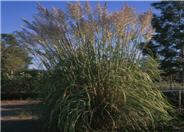
Common name:Ravenna Grass
Botanical name:Erianthus ravennae
Ravenna grass is a fabulous ornamental grass, from its striking silhouette and silky plumes to its fall color and winter presence. Emerging mid to late spring, it clumping, upright arching mound of foliage quickly reaches 3 to 5 feet. Plume stalks begin to emerge, with silky plumes emerging mid to late summer. As temperatures cool, plumes turn pinkish and foliage takes on burgundy hues. Very winter persistent. Winter birds will love the seeds. Grows 8 to 10 feet tall and 3 to 4 feet wide. Plumes are lovely in vases.
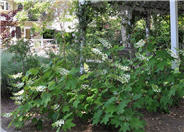
Common name:Oakleaf Hydrangea
Botanical name:Hydrangea quercifolia
Oakleak hydrangea is a deciduous, summer blooming shrub with an irregular, rounded habit growing about 6 to 8 feet tall and wide. Green leaves are large and deeply lobed, and reminiscent of oak leaves; fall color is a rich burgundy. White flower clusters appear in mid summer in erect, terminal panicles; flowers slowly age to a pinkish-purple color and persist into the fall. Mature stems exfoliate to reveal a rich brown inner bark which is attractive in winter. Fabulous in the shady shrub or foundation border. Excellent cut flower. Many selections available.
| Designer: Stephanie Duer | Flagstone Walk Garden 17 |
Photographer: GardenSoft |
Water Saving Tip:
Apply a layer of mulch around plants to reduce moisture loss.
Choose organic mulches, such as shredded bark, compost or aged sawdust.
